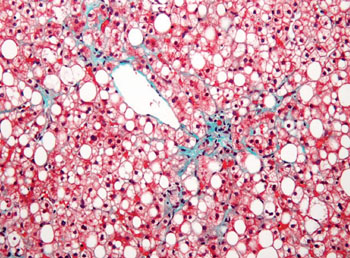Liver Values Elevated in Overweight Children with Gene Mutation
By LabMedica International staff writers
Posted on 07 Jul 2014
Genetic polymorphism has been strongly associated with liver fat content and plasma alanine aminotransferase levels in obese adults and children, but little is known about these relationships in normal weight individuals.Posted on 07 Jul 2014
Plasma levels of liver enzymes alanine aminotransferase (ALT) and gamma-glutamyl transferase (GGT) that are widely used in clinical practice for the diagnostics of liver diseases have also been suggested as useful tools in the screening for pediatric non-alcoholic fatty liver disease (NAFLD).

Image: Histopathology of non-alcoholic fatty liver disease showing the liver with prominent macrovesicular steatosis (Photo courtesy of Nephron).
Scientists at the University of Eastern Finland (Kuopio, Finland) studied a population sample of 481 Caucasian children aged 6 to 8 years who were examined at baseline and 419 children reexamined after two year follow-up. Altogether, 58 (12%) of 481 children at baseline and 71 (17%) of 419 children (205 girls and 214 boys) after 2-year follow-up were overweight.
Kinetic methods were used to analyze plasma activities of ALT and GGT (Roche Diagnostics Co., Mannheim, Germany). Genomic DNA was isolated from the blood mononuclear cells using the QIAamp DNA Blood kit (Qiagen, Hilden, Germany). The Patatin-Like Phospholipase Domain Containing 3 (PNPLA3) allele rs738409 was genotyped using an allele-specific polymerase chain reaction (PCR) assay. PNPLA3 148M polymorphisms were also investigated.
Of the 481 children examined at baseline, 283 (58.8%) were 148I homozygotes, 173 (36.0%) were I148M heterozygotes and 25 (5.2%) were 148M homozygotes. Of the 419 children re-examined after 2-year follow-up, 244 (58.2%) were 148I homozygotes, 153 (36.5%) were heterozygotes and 22 (5.3%) were 148M homozygotes. There were no differences in the genotype distributions of the rs738409 polymorphism between normal weight children and overweight children. Overweight children had higher plasma ALT levels at baseline and after two year follow-up and a larger increase in plasma ALT activity during two year follow-up than normal weight children adjusted for age, sex, body height, carrying the PNPLA3 148M allele.
The authors concluded that in healthy children the carriers of the 148M allele of the PNPLA3 rs738409 polymorphism have elevated plasma levels of ALT if they were overweight but not if they have a normal body weight. On the other hand, overweight children had higher plasma ALT levels than normal weight children even without the risk allele. These findings emphasize the early prevention of overweight particularly among children carrying the PNPLA3 148M allele to avoid liver fat accumulation and the development of NAFLD. The study was published on June 11, 2014, in the journal Pediatric Obesity.
Related Links:
University of Eastern Finland
Roche Diagnostics
Qiagen













